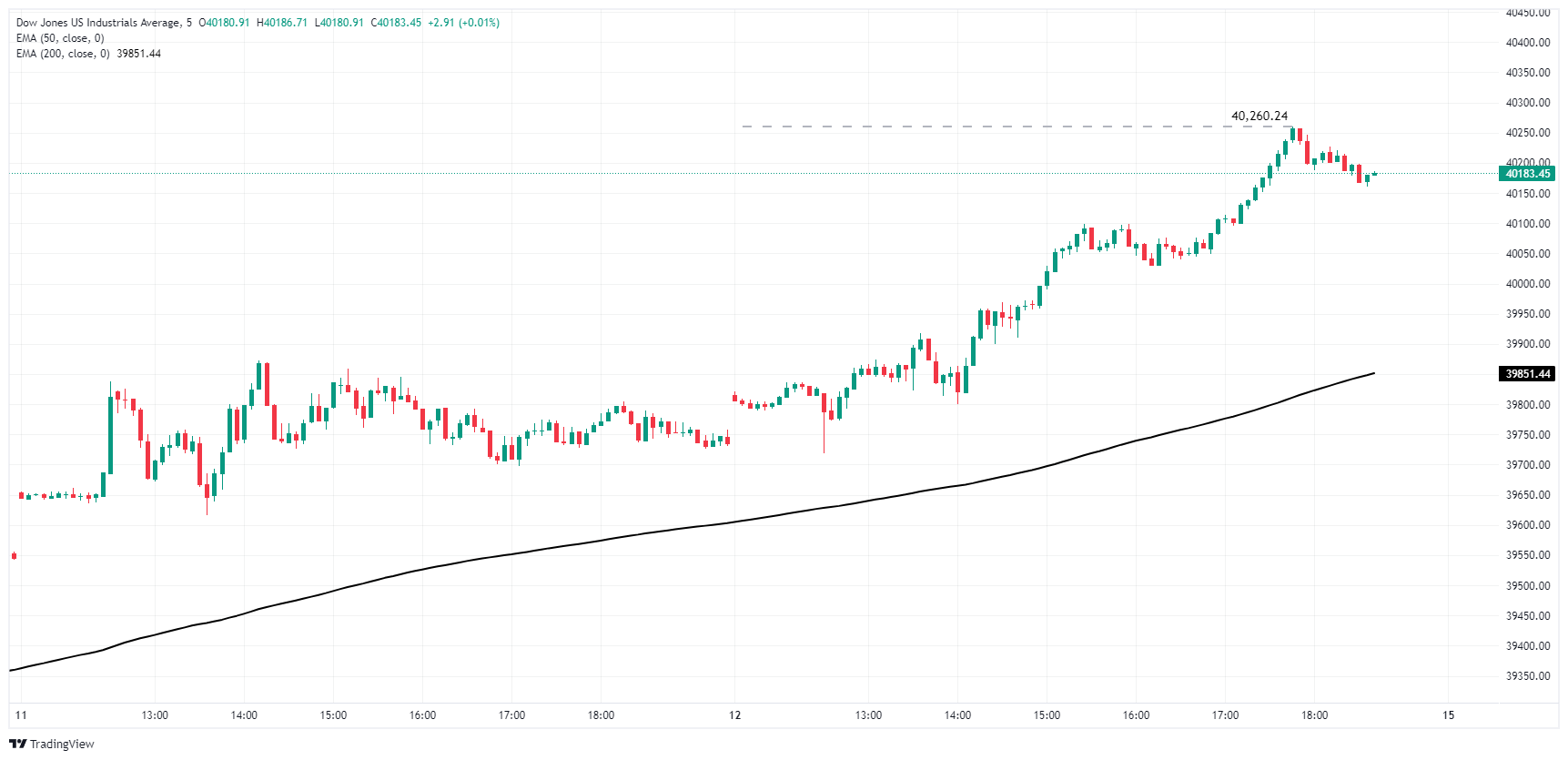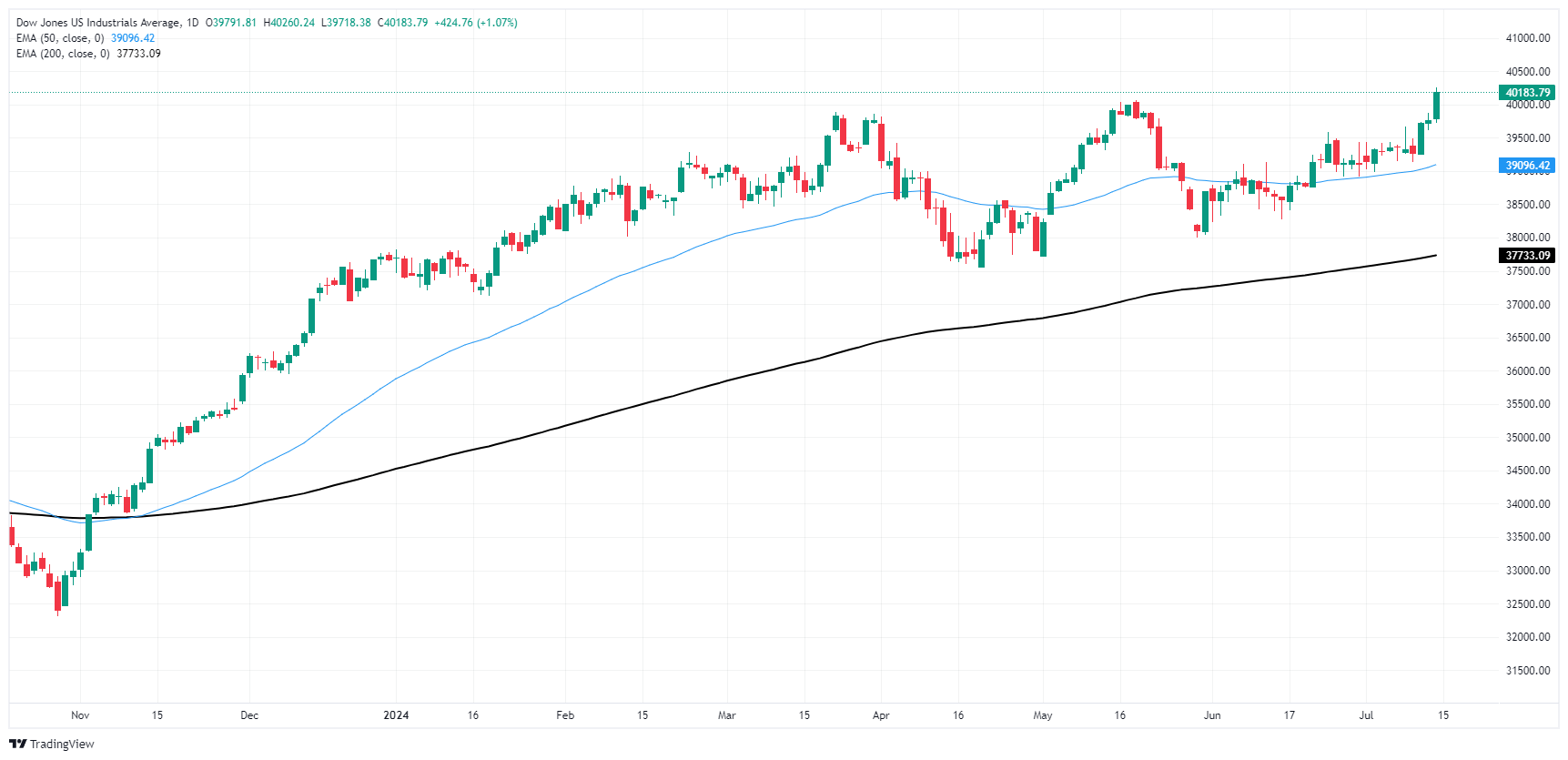- The Dow Jones rose 450 points to set a new all-time high above 40,200.00.
- Markets are largely ignoring an acceleration in US wholesale PPI inflation.
- US consumer sentiment surveys worsened, but 5-year inflation expectations softened.
The Dow Jones Industrial Average (DJIA) soared more than 450 points on Friday as markets are once again holding renewed hopes for rate cuts by the Federal Reserve (Fed) in September, even as US wholesale Producer Price Index (PPI) inflation accelerated more than expected in June. Markets have completely buried the needle on rate cut forecasts, pricing in three rate cuts in 2024 and a 95% chance of a rate cut on September 18.
US core PPI wholesale inflation in June accelerated to 3.0% year-on-year, completely eclipsing the 2.5% forecast, with the prior period figure also seeing an upward revision to 2.6% from the initial 2.3%. Despite the sharp rise in producer-level inflation, markets are refocusing on a decline in Consumer Price Index (CPI) inflation earlier in the week to lean firmly towards rate cut hopes.
According to the CME’s FedWatch tool, the rate market is betting on at least one quarter-point rate cut at the Federal Open Market Committee’s (FOMC) rate decision on Sept. 18. Rate traders are also now pricing in at least three rate cuts in total by 2024, a step above the one or two rate cuts projected by the Fed by December.
In other US data on Friday, the University of Michigan’s Consumer Sentiment Index survey fell to a seven-month low of 66.0 from 68.2 previously, undermining forecasts for a rise to 68.5 as US consumers grow increasingly disheartened about the economic outlook. The University of Michigan’s 5-year inflation expectations softened slightly in July, falling to 2.9% from 3.0% previously, but markets are trying very hard to ignore how much higher consumers’ long-term inflation expectations are compared to the Fed’s 2.0% target annual inflation rate.
Dow Jones News
The Dow Jones soared on Friday, rising an impressive 450 points and is set to post one of the index’s best three-day performances of the year. All but four of the Dow’s constituent stocks are in the green on Friday, with losses led by JPMorgan Chase & Co. (JPM), which fell -0.94% to $205.50 per share. Despite reporting better-than-expected second-quarter earnings, the stock is still falling after trading at record highs ahead of Q2 results. JPM posted quarterly profits of $18.1 billion, bringing EPS to $6.12, comfortably beating forecast estimates of $5.88.
On the bright side, Intel Corp. (INTC) is up nearly 5%, topping out at $35.00 per share as the AI market frenzy continues. Intel CTO Greg Lavender recently noted that he anticipates Intel will hit $1 billion in annual AI cloud computing-related subscription revenue by the end of fiscal 2027. While the projected growth in AI services revenue is nothing short of spectacular and is helping to further boost Intel stock, the figure is still dwarfed by Intel’s core semiconductor business, which routinely generates revenue in excess of $50 billion annually.
Dow Jones Technical Outlook
The Dow Jones hit a new all-time high of 40,260.24 on Friday, rising more than 400 points as broader markets soar. The DJIA rose more than a percent in the final session of the trading week, and the Dow Jones is now up more than 6% since the last notable low in the 38,000.00 area in late May.
The Dow Jones Index, posting new all-time highs, is now up 6.82% in 2024, and is up an impressive 24.59% from the index’s low in the 32,300.00 area in late 2023. The daily candles are trading well above the 200-day exponential moving average (EMA) at 37,733.00, and buyers will be looking to put distance between the bids and the nearest technical floor valued at the 50-day EMA near 39,095.00.
Dow Jones five minute chart
Dow Jones daily chart
The Dow Jones FAQs
The Dow Jones Industrial Average, one of the world’s oldest stock market indexes, is made up of the 30 most actively traded stocks in the United States. The index is weighted by price rather than capitalization. It is calculated by adding up the prices of the component securities and dividing by a factor, currently 0.152. The index was founded by Charles Dow, also founder of the Wall Street Journal. In recent years it has been criticized for not being sufficiently representative, as it only tracks 30 companies, unlike broader indexes such as the S&P 500.
There are many factors that drive the Dow Jones Industrial Average (DJIA). The main one is the aggregate performance of the companies that comprise it, as revealed in quarterly corporate earnings reports. US and global macroeconomic data also contribute, as they influence investor confidence. The level of interest rates, set by the Federal Reserve (Fed), also influences the DJIA, as it affects the cost of credit, on which many companies rely heavily. Therefore, inflation can be a determining factor, as well as other parameters that influence the decisions of the Federal Reserve.
Dow Theory is a method for identifying the major trend of the stock market developed by Charles Dow. A key step is to compare the direction of the Dow Jones Industrial Average (DJIA) and the Dow Jones Transportation Average (DJTA) and only follow trends where both move in the same direction. Volume is a confirmation criterion. The theory uses elements of peak-trough analysis. Dow Theory posits three phases of a trend: accumulation, when smart money starts buying or selling; public participation, when the general public joins the trend; and distribution, when smart money leaves the trend.
There are several ways to trade the DJIA. One is to use ETFs that allow investors to trade the DJIA as a single security, rather than having to buy shares of all 30 companies that comprise it. A prominent example is the SPDR Dow Jones Industrial Average ETF (DIA). Futures contracts on the DJIA allow traders to speculate on the future value of the index, and options provide the right, but not the obligation, to buy or sell the index at a predetermined price in the future. Mutual funds allow investors to purchase a portion of a diversified portfolio of DJIA securities, providing exposure to the overall index.
Source: Fx Street
I am Joshua Winder, a senior-level journalist and editor at World Stock Market. I specialize in covering news related to the stock market and economic trends. With more than 8 years of experience in this field, I have become an expert in financial reporting.







